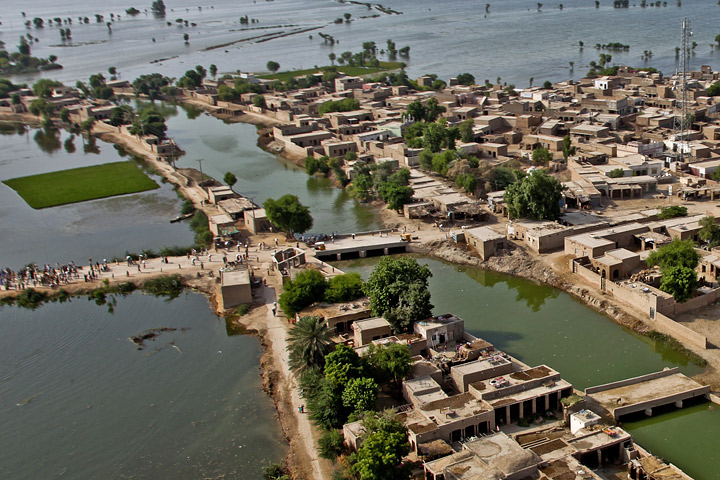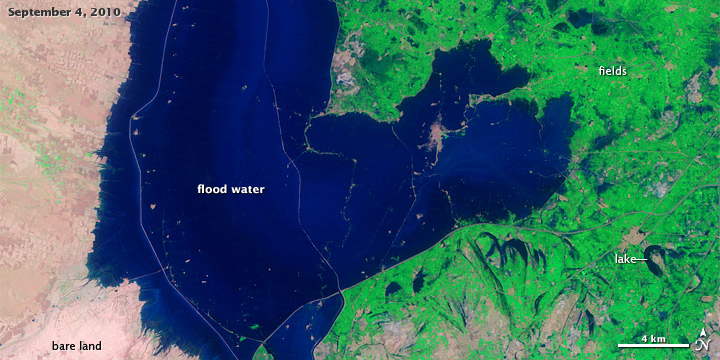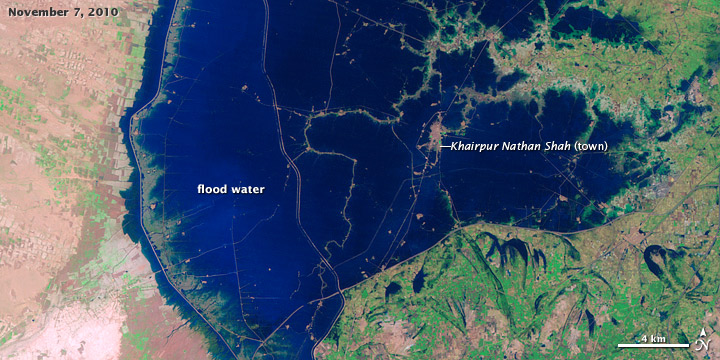

The heavy, persistent rain would have been a challenge for Pakistanis under any circumstance. Human activities, however, probably made them worse than nature alone could have.
Vegetation naturally reduces the risk of flooding by soaking up precipitation, so almost every time humans remove trees, shrubs, and plants from the landscape, they increase the risk of floods. Decades of deforestation in Pakistan, (PDF) particularly in the Swat Valley, have left the landscape less able to absorb moisture.
Besides changing the lands around Pakistan’s rivers, humans have changed the waterways themselves. Most of the water in the upper Indus River basin runs down from glaciers in the Himalaya and Karakoram mountain ranges. Since the flow is not always sufficient to meet the needs of people downstream, dams, levees, and channels have been built to divert water for irrigation and to hold on to the sparse precipitation that the region usually receives.

Construction—including dams, roads, and canals—can divert water from its natural path. This can exacerbate flooding, or cause water to pool in areas without an outlet, sometimes for months. (Photograph courtesy Defense Video & Imagery Distribution System.)
Kuntala Lahiri-Dutt, a social geographer at the Australian National University, notes that while many of the diversions from the Indus River probably date back to the British colonial days, increasing amounts of river water have been diverted for irrigation in recent decades. Many property owners also have erected their own embankments and levees in the name of flood protection.
The majority of this irrigation infrastructure has not necessarily been well maintained over the years, says Dath Mita of the U.S. Foreign Agricultural Service. “The Pakistan irrigation and levee system is very extensive—not just large structures lined with concrete, but also channels that farmers have dug on their own land,” he says. “A system like that needs sustained maintenance, and because of accumulation of silt deposits over the years, the channels probably had a lower capacity to move water.”
As Lahiri-Dutt wrote in September 2010:
Each human interference into a natural river system has its consequence: when excessive amounts of water are drawn out of its channel, a river channel becomes less efficient and loses its ability to quickly move the water. When levees are built along the banks, the sediments get deposited on the riverbed, which gradually rises above the surrounding plains. Not only does this enhance the flood risk, the levees standing as walls also make it difficult for the floodwater to return back into the channel once it has spilled over.
Hence, there were manmade bottlenecks where water could pool whether people wanted it or not, notes Clift. In 2010, structures that were initially ineffective in containing the surge of rainwater eventually turned out to be very effective at holding it in the wrong places.



Some parts of Pakistan remained under water for months after the rains subsided. These false-color satellite images show flood water (blue) in western Sindh province in September 2010, November 2010, and January 2011. It is apparent that roads and other infrastructure constrained the flow of flood water. (NASA images by Robert Simmon, using data from Landsat 5.)
“Flooding this severe would be hard for anybody to manage,” Clift adds. “The grim reality is that, over the long term, Pakistan is a really dry place. Most of the time, they need that water infrastructure.”
Indeed, as flooding swamped areas along the Indus River, dust storms blew through the western reaches of Pakistan and in Afghanistan.